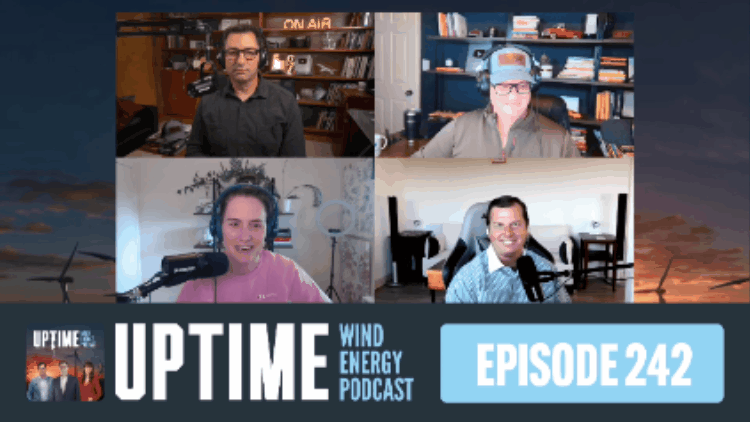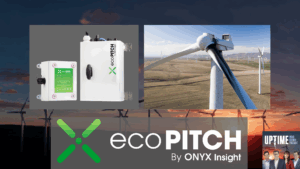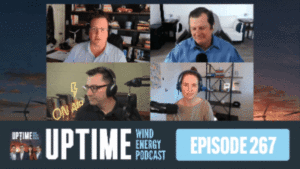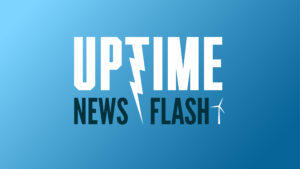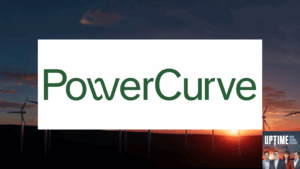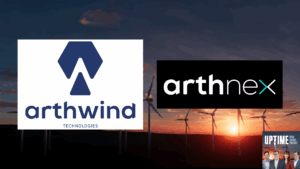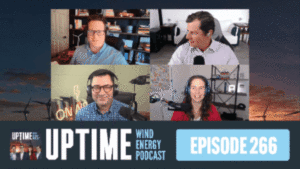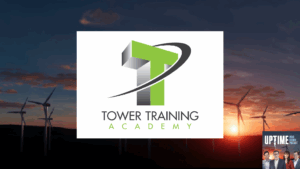Podcast: Play in new window | Download
This episode covers Vestas’s manufacturing growth in Italy and Siemens Gamesa’s quarterly results showing both gains and ongoing challenges. The hosts explore how the U.S. election results could reshape renewable energy markets, with discussions ranging from grid infrastructure to natural gas expansion. And an in-depth look at quality control concerns at GE Vernova’s LM Wind Power blade manufacturing facility in Canada, where allegations of falsified quality control data have emerged.
Sign up now for Uptime Tech News, our weekly email update on all things wind technology. This episode is sponsored by Weather Guard Lightning Tech. Learn more about Weather Guard’s StrikeTape Wind Turbine LPS retrofit. Follow the show on Facebook, YouTube, Twitter, Linkedin and visit Weather Guard on the web. And subscribe to Rosemary Barnes’ YouTube channel here. Have a question we can answer on the show? Email us!
Pardalote Consulting – https://www.pardaloteconsulting.com
Weather Guard Lightning Tech – www.weatherguardwind.com
Intelstor – https://www.intelstor.com
Wind Energy O&M Australia Conference – https://www.windaustralia.com
Allen Hall: An endangered sea turtle that was found about a year ago, some 5, 000 miles from its native waters, has been released back into the Gulf of Mexico, according to the Houston Zoo. The sea turtle was found off the coast of, guess where? The Netherlands, after becoming entangled in the net of a commercial fishing boat.
The zoo said the turtle apparently was carried by currents until it was found, and the U. S. National Fish and Wildlife Service secured the turtle’s return. Guys, there’s a really interesting bit. Some fishermen somewhere realized that this turtle didn’t belong off the coast of the Netherlands and decided to return it.
Of all things. They took it to the Rotterdam Zoo the Rotterdam Zoo where it was nursed back the health. And then had a, must have a first class flight back to Houston where it was put back in the Gulf of Mexico. But this little turtle went a long ways. 5, 000 miles is quite a ride, right?
Joel Saxum: I can’t imagine it was doing very well in the cold water up there either.
Cause right now, even now the Gulf of Mexico is 80 degrees Fahrenheit. Yeah, he, the
Allen Hall: turtle at some point had to know it wasn’t in the Bahamas anymore, right? It’s not gonna swim back from there.
Rosemary Barnes: I saw a story recently about a king penguin that that swam from Antarctica to Australia to Perth.
It was it’s not that far, I think it was like 3, 000 kilometers or maybe a little bit more, but similar thing of yeah. Animal just, just the kind of point in the direction and then just keep going until they reach land. It’s some decent persistence.
Allen Hall: Isn’t it crazy when you think about how animals have moved around the planet?
And then you, that’s impossible. And then Rosemary says there’s a penguin that’s got about 1, 500 miles, just taking a light swim.
Joel Saxum: That’s crazy. There’s a book about this called Super Navigators, and it’s really fascinating, actually, to be honest with you.
Allen Hall: This turtle is back home in the warm waters of the Gulf of Mexico, which is a great story, right?
Gulf of Mexico for the winter. Welcome to the
Uptime Wind Energy Podcast. I’m your host, Allen Hall, and I’ll be joined by my Uptime co host after these news headlines. Thanks A major expansion of wind turbine manufacturing is underway in Toronto, Italy as Vestas begins production of its V236 15MW offshore wind blades. The facility will produce 115. 5 meter blades capable of powering 20, 000 European households each year.
The expansion, supported by EU recovery funds, will create 1, 300 new jobs in the region. The Port of Toronto has granted Vestas a nine year concession to use its logistics platform, establishing the port as a strategic hub for wind energy component manufacturing and distribution. This development marks a significant step in expanding Europe’s wind energy supply chain.
Siemens Gamesa reported a mixed fourth quarter performance with revenue growing significantly to 3. 1 billion. billion euros, up 19 percent compared to the same period last year, driven largely by increased offshore wind business activity. However, the division continued to face challenges, posting a negative profit of 472 million euros for the quarter.
While this represents an improvement from last year’s 670 million euro loss, the results still reflect ongoing project margin pressures due to quality issues and increased product costs. Orders were moderately down to 4. 1 billion euros compared to 4. 2 billion euros in the previous year. The company’s order backlog increased to 38 billion euros, supported by a major North Sea order worth 2.
9 billion euros. Looking ahead to fiscal 2025, Siemens Comansa expects revenue growth to decline between 5 and 9 percent as it continues working towards achieving break even performance by fiscal year 2026. Scottish Power Renewables has finalized a 1 billion pound agreement with SMOs CESA to supply 64 wind turbines for its East Anglia two offshore wind farm.
The project located off England’s East Coast has a capacity of nearly one gigawatt and will use SG 14 SG 36 DD turbines with a 236 meter rotor diameter. The 115 meter blaze will be produced at Siemens GI Mesa’s whole facility. which has grown to employ 1, 300 people following the addition of 600 new staff in the past year.
The 4 billion pound wind farm is expected to generate enough clean energy to power nearly 1 million homes. GE Vernova, the world’s third largest wind turbine manufacturer, will continue its pause on seeking new offshore wind turbine orders while awaiting improved market conditions. The company currently has a 3 billion backlog that will take two years to complete.
CEO Scott Straszak cited supply chain strains and rising interest rates as key challenges. The company’s offshore wind turbine unit has not added to its order backlog for almost three years, instead focusing on executing existing projects. GE plans to standardize its turbines to improve quality and reduce costs, though it announced potential cuts of 900 jobs in its offshore wind unit this September.
The Bureau of Ocean Energy Management has completed its final environmental impact statement for the proposed 2. 4 gigawatt south coast wind project. The development includes 147 wind turbines and five offshore substations with eight offshore export cables, potentially making landfall in Brighton Point or Falmouth, Massachusetts.
The lease area covers 127,000 acres, situated 26 nautical miles south of Martha’s Vineyard, and 20 nautical miles south of Nantucket. That’s this week’s top. News stories. After the break, I’ll be joined by my co-host, the Chief Commercial Officer of Weather Guard Lightning Tech. Joel Saxum the founder and CEO of Pardalote Consulting, Rosie Barnes.
And the founder and CEO of InterStor, Phil Totaro.
Unlock your wind farm’s best performance at Wind Energy O& M Australia, February 11th to 12th in sunny Melbourne. Join industry leaders as they share practical solutions for maintenance, OEM relations, and asset management. Discover strategies to cut costs, keep your assets running smoothly, and drive long term success in today’s competitive market.
Register today and explore sponsorships at www. windaustralia. com. All
Allen Hall: So preparations are underway for Wind Energy O& M Australia in Melbourne on February 11th if you haven’t visited windaustralia. com, you’re missing out because the registrations are active. A lot of people have registered already and the sponsors are rolling in.
Joel Saxum: So as we’ve been putting this together, we’ve had a lot of reach outs.
We’ve been reaching out on LinkedIn. We’ve been reaching out an email to people down in Australia and around the globe. And we’ve had quite a few people reach back out to us saying they want to be involved. So we’ve got a couple of panelists line or some great panelists lined up. We’ve got a few that we’re in the pipeline right now to be sponsors, and they’re going to bring some crazy, innovative ideas, some things that are happening around the wind world where they’re actually, they’re helping operators in a big way.
But we can’t say who they are quite yet, but stay tuned for that.
Allen Hall: Yeah, it’s going to be a great event. Rosie’s going to be there. At least she promised to be there. Bill’s going to be there. Joel’s going to be there. And I guess I’m coming too. So it should be a good time. All the uptime crews will be there.
And if you’re interested. In sponsoring or attending, you need to visit windaustralia. com. Rosie, in the U. S. we had an election. You may not have heard about it, but,
Rosemary Barnes: Did you?
Allen Hall: Yeah, we did.
Rosemary Barnes: Anyone I know involved?
Allen Hall: Donald Trump and Kamala Harris have competed and at least at the latest count it looks like Trump will be president come January 20th.
Now, this has sent the renewable energy world all aflutter. There’s a lot of concern about it because during the election campaign, for offshore wind, Trump promised to shut down all the permitting for, or put a suspension on all the permitting for offshore wind. I don’t even sure that is really possible without having some valid reason, Joel.
I’m not sure that can happen, but there’s a lot of people that are concerned about it, and you’ve seen a number of LinkedIn articles saying the world is ending, and I’m not sure that’s the case.
Rosemary Barnes: I, I don’t see it from an outside perspective. I can’t see that it’s going to be disastrous for, Energy transition in general.
However, Trump really dislikes wind specifically. And I think that wind was already probably not looked after as much as all other energy transition technologies from the IRA. That’s my belief anyway. So I do think it could be bad for wind. It’s definitely not a tailwind for wind energy, right?
It’s Yeah. How much of a headwind remains to be seen. But I don’t want to get into the, it’s immensely comforting to me that I am not a U S citizen and I don’t really need to care that personally about it. Like I don’t need to get personal about it. Of course I care a whole lot about the energy transition cause that’s a global thing.
But other than that, I can avoid getting too invested. But yeah, and some of the personality involves, personalities involved. I’m, like thoroughly sick of seeing what they have to say. But that said Elon Musk, love him or hate him. And it’s probably, fewer people outside of the US who love him these days.
I still would find it really hard to believe that he would be keen in scrapping all kind of, energy transition incentives obviously electric cars, that’s still a big part of why he is the, I think he’s the wealthiest person in the world, right? And a lot of that’s to do with Tesla.
Tesla stock has gone up heaps, like 60 percent or something in the last month. That’s a part of it. And I also, as crazy as he’s gotten on yeah, any range of topics that he talks about these days, I haven’t actually heard him say anything crazy about the energy transition.
I haven’t heard him talk about it at all for a long time, but the last time that he was publicly saying stuff about energy. In the, after the Twitter takeover and, the foray into all sorts of other topics that I disagree with his opinions on. He was still saying stuff that was sensible to my ear about energy.
So I am cautiously, optimistic that his presence will actually, moderate the kind of damage that Trump might be inclined to, to do about that. So yeah, we’ll see. And there’s a lot of big unpredictable personalities involved. So I wouldn’t like to get too rational about my predictions and think that, that it’s possible to have any certainty, but I’m not totally despondent about, I would struggle to believe that it’s going to be catastrophic for the global climate.
Joel Saxum: I think there’s a couple of things to think about that for wind energy professionals or energy transition, anybody involved in it can sit back and be a little bit more comfortable. These are my thoughts. One of them is one of the things that Donald Trump ran on was deregulation and fixing some permitting problems.
If you do this, those things for oil and gas, say on the, dealing with public land or lease areas or any of these sorts of things and in interstate cross boundary pipelines and that kind of stuff, those are the same kind of regulation, the same kind of regulatory bodies that regulate wind and or solar and or batteries.
So if we’re deregulating that side of things, it actually might make regulations easier and permitting processes quicker for wind. So that’s one thing. Another one, if you look back just at history, 2016 to 2020, Donald Trump was president once already. And during that era, we had a boom in wind energy development.
And most of that was driven. This was pre IRA bill, of course, right? But most of that was driven because capital was cheaper at that point in time. The cost of capital was not as high as it is. Now, or has been for the last few years. And so if we see that same kind of economic trend as what happened in 2016 to 2020, based on policies, I think that you could actually see development at, at least on the onshore level, spike, I think you could see it go up because cost of capital, if the economy is doing better, the global economy is doing better, the cost of capital is cheaper.
And that makes it easier for developers to buy into things and make it happen. And that’s just a couple of thoughts.
Allen Hall: But there’s really nothing that a president can do inside of a state anyway.
Joel Saxum: Federal waters. That’s what we, that’s one of the things he ran on as well was, I’m going to do this and leave it to the States.
I’m going to do this and leave it to the States. That’s actually the way the constitution is designed in the United States. It’s power to the States. The federal government’s just there to support. And over the years, the federal government has gotten bigger and bigger and bigger. That’s another thing Rosemary, as Elon Musk has said we’re going to reduce some of the waste in the government and try to.
Make it not so big. So I don’t think that, everybody doom and gloom about wind energy in because of the selection. I actually I’m cautiously optimistic to see what happens January 20th. And for the first a hundred days and over the four year course year to see what happens, because I don’t think it will be as.
Bad as is made out to be today.
Philip Totaro: If you want to talk about how cost of capital is impacted, we also have to talk about interest rates. And when we talk about interest rates, you got to look back historically at periods when interest rates were unseasonably high and what happens during the times when interest rates are being reduced as a frame of reference for where we are right now, by the way, when you have historically high interest rates and they start, being reduced, there’s almost inevitably a period of recession where we are inevitably in 2025 going to have a recession.
How deep it is and how intense it is it’s, it’s inevitable that this is going to happen. So keep that in mind. Now, the consequence of it is when we’re in a recession, interest rates get reduced to Almost zero or significantly reduced down to the point where you don’t have those kind of barriers to projects anymore.
So from the interest rate perspective, yes, interest rates are going to come down. We’re going to have to deal with this recession that is, as I said, is inevitable 2025. Hopefully it’s a mild one. Hopefully it’s a short one. And again, this frankly was going to happen regardless of who won the election and whatever the Federal Reserve was going to do and what level of influence the executive branch has over, the, this independent Federal Reserve Board.
So that’s the first and probably the most important aspect of this. The second thing that. What we need to look at is what can a president do with an executive order? The reality is, can offshore wind be blocked? Not as much as people think. What an executive order could do is slow down the Department of Interior, and specifically from issuing any approvals for projects that aren’t already either environmentally approved or commercially approved for operation.
Allen Hall: And Rosemary, executive order is one thing, but if you look at the GE Vernova statement and now today the Siemens Energy released its quarterly prospectus, the drill baby drill is something that they’ve already planned for. Natural gas turbines. are big money. G. E. Vranova’s stock has gone up 17 percent this week.
There’s gonna be a huge push into natural gas, and the closing of a lot of coal fired electricity factories. And the reason they’re giving is AI, that in order to power all these data centers and to make AI magic, They’re going to need a lot of power and because they don’t have the renewables where they wanted to, and nuclear is not really an option in the States so much, in fact, they shut it down.
It’s all natural gas. Does that make any sense?
Rosemary Barnes: I know that the projections for, future electricity usage in the United States, 4 percent of the increase is associated with data centers. I’m pretty sure I’m remembering that correctly, maybe it was 4 or 5%. It’s very, it’s a nice convenient thing.
If you have an incentive to say that there’s going to be increased electricity demand, then that’s a nice reason to attach to it. I know that in their planning most utilities around the world, and I’m pretty sure that a lot, maybe all of them in the UK. US are the same. The way that you make a return is by making an investment and then you’re allowed to, and a guaranteed rate of return on that.
So they always want to invest in more electricity generation. And even though electricity demand has been very flat for, I don’t know, what, like 20 years or a long time anyway in the US and most developed countries, they have been looking back at their projections for the future.
They’re always predicting that it will increase. It’s, it’s been flattened out. It’s about to increase massively. That’s what they’ve been saying. So take it with a grain of salt.
Allen Hall: Hang on, Rosemary. I don’t think you take it with a grain of salt here because Hitachi, which is the largest manufacturer of high voltage transformers has like a four year backlog.
There’s a lot of electrical infrastructure that is happening. So that feeds into your consensus.
Rosemary Barnes: Yeah, so the whole point of the, the energy transition, we’re transitioning to electrification of a lot of things that used to be, served by burning gas or by burning petrol slash gasoline.
So there is going to be a lot more electricity used as we transition. So I think we’re all expecting that to happen. It, it’s starting to ramp up now we’re in the early days of it. I don’t think we see a huge difference in the amount of electricity generation that we need yet, but we’re all expecting it right.
So whether it’s because of. Data centers. No, it’s not. It’s not because of data centers. That’s one of 20 other factors of the same or more of an impact. Yes, we will need more electricity.
Allen Hall: Let me ask you this. If we’re going to put more natural gas turbines onto the grid, To produce electricity, we’re going to need more grid.
If there’s more grid, does that allow us to have more renewables that plugs into that grid? Because if one thing is going to happen, they need to, and the drill baby drill does happen, they’re going to have to hang transmission line and have switchgear to take that electricity to where they need it. And once that happens, doesn’t that open up the possibility to more renewables popping online?
Solar and wind.
Rosemary Barnes: Allen, you’ve got the talking point wrong. If you’re playing the role of gas industry booster, everyone knows you only need transmission for renewable energy and that nuclear or or fossil fuels don’t need any transmission because, everyone’s got like a rooftop nuclear power plant or a rooftop gas turbine.
And That’s how it works. So yeah jokes aside, yes, more transmission. But the other thing is that like gas, a gas power plant is super fast to build. And it’s of the kind of project that utilities everywhere are very used to doing. That’s another thing with the planning.
If you say. Okay, we’ve had flat demand for ages. And now it’s all of a sudden about to increase massively demand. We need to put a gas turbine in because it’s the only thing we can do fast enough. That is another little bit of, I think like a forward projection that just like they’re working backwards from, We’ll have a gas power plant because it’s the easiest thing to do and we can, get a return on our investment.
But it’s, like it’s unlikely to come on as fast as they’re saying. And with a little bit more time, you could plan a cheaper system if you would, yeah, build out more transmission and more renewables. And, Maybe there will be some new gas peakers, like I’m personally not opposed to gas supporting the energy transition while we wait for batteries to get cheap enough that they can, completely eliminate the need for gas peakers, which they are, by the way, already like strongly making inroads into that in California and also Texas.
I would say it’s a short term horizon that the, rush on gas turbines would be for rather than a long term one.
Joel Saxum: Rosemary, what is, maybe you know this, I think of anybody you’d probably know this on the panel here, what’s the average size of a gas, like a natural gas powered power plant?
Four to five hundred megawatts. Okay, so you’re the size so one gas plant is the size of A large wind farm. You’re talking 100, 150 tower wind farm is the size of one gas plant. Ish.
Rosemary Barnes: Ish. I think it’s a wrong comparison though. It’s like batteries. Batteries is the right comparison. Like how, because batteries are also super quick to put in.
The world’s first big, like grid scale battery. Was in South Australia, and again, it’s, Elon Musk. They got it up in three months. Three, three months from when the contract was signed. Maybe about six months from when they first started talking about it. Like that’s fast.
Joel Saxum: He’s not normal. They also built like the gigafactories. They said they’re gonna take five years to build the first gigafactory. And they did it in 18 months. So that’s an Elon Capital Projects thing.
Rosemary Barnes: But still, when you look at, when you look at construction timelines for big batteries, we’re talking a year, maybe two years for a big project.
We’re not talking like nine years for a nuclear power plant, like it’s, it is very different. So they’re also fast and as prices are still dropping and people are starting to see how profitable they are in when you combine batteries with. A lot of solar power, then you can get most of the year you can get really cost effective, flexible energy system, electricity system.
I think we’ll see more of that.
Joel Saxum: I know, Allen, when you and I are driving around West Texas earlier this year, we saw a lot of, Pseudo co located renewables and batteries, renewables, batteries, and data centers. And the data center thing is not going to slow down, right? Like we just saw this other one and Allen, you mentioned it briefly, but there was Three Mile Island was going to be unmothballed.
And another plant was supposed to be converted over to being used for data centers. And they were going to take these nuclear power plants and use them for data centers. And that got squashed by FERC. So the companies that were associated with that, I think it was Constellation, their stock dropped like 15 percent overnight when that happened.
Allen Hall: That’ll change though, don’t you think, Joel? I think that those nuclear power plants will get fired back up again with a new administration. I think that’s going to be high on the priority list. Unless there’s some safety issue that Is preventing it, but that wasn’t even in the discussion point, I don’t think.
Joel Saxum: If you look at nuclear doctrine for energy, one of the big reasons behind not making it large scale, at least coming out of the United States, was to not share nuclear technology around the world. Oh hell, North Korea has it now.
Allen Hall: Every Iran has it. It’s everywhere.
Joel Saxum: It’s everywhere now. Why not?
What’s the why are we holding back?
Allen Hall: It’s gonna be well, I assume Rosemary They will televise the inauguration into Australia’s to make sure everybody sees it and I know you’ll be Attune to that. I’ll have to get the VCR ready so you can record it. This is going to be like at two in the morning for you, I’m sure.
Philip Totaro: She’ll be watching the Australian Open Tennis on Nine Gem.
As busy wind energy professionals, staying informed is crucial. And let’s face it, difficult. That’s why the Uptime Podcast recommends PES Wind magazine. PES Wind offers a diverse range of in depth articles and expert insights that dive into the most pressing issues facing our energy future.
Whether you’re an industry veteran or new to wind, PES wind has the high quality content you need. Don’t miss out. Visit PEs wind.com today.
Allen Hall: If you’ve been following the news very closely in Northern Canada there’s been some reports of. Quality control problems at the Vernova LM wind power blade manufacturing facility, and as reported in one of the Gaspé newspapers, there was an internal investigation revealing employees were allegedly directed to falsify quality control data.
And that made blade data was reportedly associated with poorly made blades. The plant management had a point system that encouraged skipping verification steps. This is all alleged, of course, still. And those are some of the 107 meter blades that are at vineyard wind at the moment that are struggling.
and GE is trying to take corrective actions for that. It apparently a senior employee at GE Vernova went up to the gas bay plant and told everybody what had gone on. This is a big deal. There’s been a lot of allegations, and I have read so little about this, but I’ve heard it from so many places over the last 12 months, that there has been some doctoring of quality data.
Particularly the Canada plant is the one that I hear the most about and which becomes just horribly bad for Vernova and LM as, that’s, it sounds like from what I can tell, and the. The events, if you lay them out on a timeline, pretty much as GE upper management figured out this was going on, heads were rolling and rightly it looks like GE lawyers came in and started to suss out what was happening, but the damage is already done. Now, as a group of us, I can imagine each one of us is thinking, this is insane. What are we doing as an industry when this is going on? And Part of it may just be just the pressure.
And there was pressure to push out blades. There was part, a lot of pressure to get blades delivered on time, particularly offshore, which GE really hasn’t done. Been taking orders for years for now. They just want to be done with it. There’s a lot of internal pressure here, but this is definitely not the right way to go about it.
Do you see, is there more of this? Is this wider spread than just this one place? What are we all hearing?
Joel Saxum: Yeah, let’s hope not. I know one thing I did see was an article today that stated that head of GE Vernova still says sales for offshore wind are on ice. They’re not even pursuing them. So they’re not even going after them.
They’ve shut that thing down. And Allen, what you alluded to earlier, you and I watching through LinkedIn and stuff, they’re head of offshore. Was it June or July? Yeah, and is now
Philip Totaro: retired. And they replaced the executive team at LM previously, so they’re, because as it’s, as the allegations go, the LM executives were, and again, whoever directed them to if it was self directed or, Encouraged by whomever we still don’t know, but the report is that they put in a quote unquote points system and we’re tracking whether people were, getting things done in a timely fashion, potentially at the expense of quality.
And that’s not an environment that is, it’s obviously unhealthy from a corporate standpoint, but it’s also a really bad look for the industry. At a point in time when, the people at, in and around, The vineyard wind project are already apoplectic about, a one blade having a failure and leaving, some shards of fiberglass in the water.
The fact that it may have been, induced deliberately by, executive order that’s extremely concerning.
Allen Hall: But isn’t that a part of the problem when we have the headquarters of a blade manufacturer so far away from the manufacturing facilities? Unless you have a really tight control of what’s going on day to day, craziness I’ve seen it, I’ve worked in aerospace forever, I’ve seen the manufacturing facilities, that seems really indicative of that situation where the management is isolated away.
This is a case about Boeing that the Boeing headquarters is in Chicago, not in the Seattle area where they’re making airplanes. That’s a huge problem because the oversight is thousands of miles away from the actual working activity. If it’s something where your job depends upon a quality product coming out the door, typically you like to be somewhere near that.
Wind is hard because you’re making blades all over the place. It’s a global business.
Joel Saxum: I think an important thing here is Rosemary on the panel here because she’s the only one of us that have spent time in a manufacturing facility for blades because there’s a million things in my, I’ve walked through the processes before, right?
So there’s visual inspections, there’s certain times that, molds are able to be open, molds have to be closed on time, resins that have to set up in a certain way, glues that have to be, so we don’t know what. These falsified documents and I want to stress allegedly falsified. We don’t know this.
This is a newspaper and some people in the industry talking. So what are some of these things, Rosemary, that do, in your mind, where could this have gone wrong? What could have happened here?
Rosemary Barnes: Yeah, Guthrie is the first wind turbine blade factory that I ever set foot on. I spent two weeks there.
As soon as I started working at LM Wind Power, all the engineers in LM do a week usually of training in a factory to learn all of the different processes. It’s really important when you’re. Looking for a company that you know, you’re designing, but it has to be manufactured. It’s really important that, the realities of that, the part that I think that you would be able to to swap data out more, most easily.
And what would make the most difference would be some of the scans. They do a bunch of non destructive testing on certain aspects of the blade. And the images that are taken are usually saved and you can look back at them afterwards. Some of the defects that I’ve worked on they’ve gone back to say, okay let’s see if we can find something in the scan that we missed, because, there’s a lot of images generated from one blade.
And some of the analysis is being done with AI and maybe there’s something missing. So that would be my guess what would be the easiest part of it, the whole thing to falsify. But I’m, my mind is blown that someone would do that because it’s one thing to fudge things that aren’t important to save time.
But it’s another thing, like when you know that this quality stuff matters. Yeah, like it’s definitely levels. Several levels beyond the worst thing that I ever saw working in a factory. And I am really disheartened by the fact that it has happened in our industry and happened to my previous employer.
And it happened at a factory that, I worked and knew people and and liked them. So yeah, just overall dis, disappointing is, times 10.
Joel Saxum: So Allen, you’re, yourself being like an engineering manager in the past. Is this look like a cultural issue or does this point to a person or an administration that directed things?
And how do you fix it? Do you go wipe that factory clean or what does it look like?
Allen Hall: Yeah. When this has happened in situations, I’ve been near. Goes on as the lawyers come in, because there’s a legal consequence to this, and the company can be brought to criminal court by the, in this case, Canada, or Quebec even there are going to be some consequences here more than likely.
And the company hate that.
Rosemary Barnes: It’s a small town, right? It’s a big employer in that region. And it was a big deal when that factory got started, it was actually by a guy who was a local and had gone away and then saying, okay, we should be able to have a factory in my hometown. And he he made it happen.
And it was really important for the area because traditionally it’s a lot of seasonal work there. And this was an employer that operated year round. Yeah. It’s not going to be easy to just fire. the, all the workers and start again because you won’t have, you won’t have that pool of potential labor there.
Management, yes but otherwise they’re gonna be shutting down the factory if they have to fire everybody.
Allen Hall: I think they’re bringing in workers. Some of the news reports that have appeared over the last six months or so say that that facility was bringing workers from outside the country on, what, six month work permits because they didn’t have enough people to support it.
Yeah.
Joel Saxum: 179 days. See you later.
Allen Hall: So that could lead to it, in my opinion, if you’re a transient worker in a factory and you’re being told to push something out the door, it leads to those conditions. Of wrong decisions being made.
Rosemary Barnes: If you’ve got no future there anyway, then.
Allen Hall: Exactly. I get I’m only going to be here for an 80, 180 days.
I need to make money and go back to my home country. I’m going to do what they tell me to do. And that’s where I say that the headquarters, some of the leadership of the company have to be kicking the tires all the time. That is just one of the things you have to do. You have to be constantly checking up further down the chain.
And it’s so hard. When you are literally thousands of miles away, Gaspé is not near Quebec, right? It’s how many hours of a drive is it once you get to Quebec to land?
Rosemary Barnes: Like 10 or something, 10 or 12. It’s a long drive.
Joel Saxum: I’m going to put it, I’m going to put a different hat on, and I’m going to put on the hat of a developer, right?
We know, okay, that GE has stopped selling offshore wind turbines right now. However, I’m going to look at the situation that happened in that factory and I’m going to try to see if that same situation, migrant workers, like you said, the engineering headquarters removed from the factory. I’m going to see if that same situation is happening at where I may be getting my blades from.
And I’m going to have a better microscope. On the factory where I’m getting my stuff.
Rosemary Barnes: Hold on. We can’t blame the migrant workers when this was management that were signing off on this. It would have clearly contributed, but management wasn’t there on, six month visas and then they just left the company.
I hope, if they were, that’s a pretty, pretty obvious weak point, but I’ll be, yeah, pretty certain that’s not how it worked. They have to be fired, obviously, all those managers. And, yeah, consider But
Joel Saxum: I want to look at it this way. If I’m looking at the exact same situation in another place where I’m getting product from, I’m going to look into it a lot harder.
That’s me.
Philip Totaro: But Joel, let’s take that conversation one step further. Rosemary just made mention of something about how long it took to perfect the design and manufacturing process for that blade in the first place. Look at what the Chinese are doing. They’re building blades that are literally twice the length of the one that GE has, and it’s GE.
They’ve got, what, 180 year history and pedigree of building products and all that. These Chinese companies are now trying to go out there and build a 300 meter rotor. On a 25 megawatt wind turbine. How is that even going to happen?
Allen Hall: I don’t know. I just want it fixed. I want this process to stop whatever caused that situation.
If it is what it has been alleged to stop. And from what I can tell, GE. Bonova came in and just cleaned house. That’s what it looks like to stop it immediately. And that may be part of the reason why they’re not looking to get back into offshore wind also, is that they have so much to undo that they need time to undo it.
Philip Totaro: Potentially, but they’re also withholding sales because they’re not getting, they’re asking for a price increase to accommodate, a, Inflation, et cetera, et cetera. Yeah. And they’re not getting those, that price increase. So their management has also said, we’re not taking the risk on margin anymore, particularly when, if you uncover a situation like this and it introduces a potentially huge financial liability to the company, you can’t be doing that on thin margins.
You have to be doing it where you’ve got cash in the bank.
Allen Hall: The oil and gas companies do.
Joel Saxum: You got to operate on an 80 percent margins for 30 years, and then you can have the cash.
Allen Hall: That’s going to do it for this week’s Uptime Wind Energy Podcast. Thanks for listening. Please give us a five star rating on your podcast platform and subscribe in this notice below to Uptime Tech News, our weekly newsletter, and check out Rosie’s YouTube channel, Engineering with Rosie, and we’ll see you here next week on the Uptime Wind Energy Podcast.



